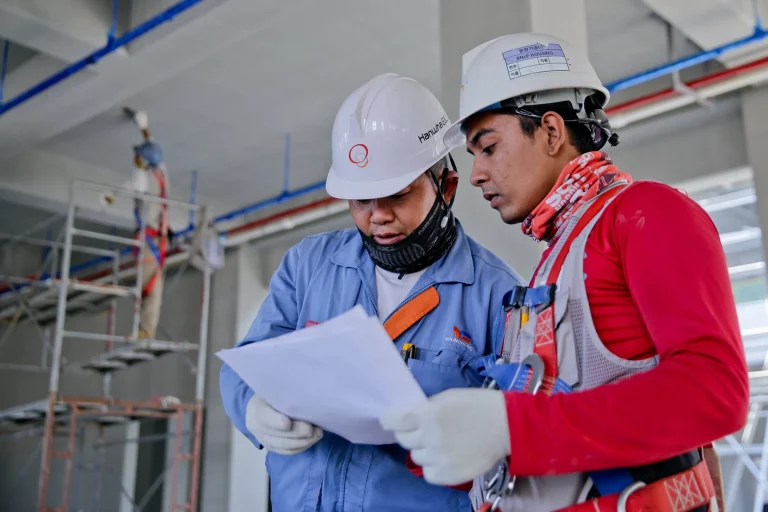Every business, no matter how big or small, needs a set of policies and procedures to keep its employees and customers safe. Let’s break down exactly what a safety management system is and how you can implement it into your organization.
All of the professional skills and qualifications in the world won’t stop potential accidents from happening. When everything’s said and done, you need detailed policies and procedures in place to keep your co-workers and customers safe.
But here’s the thing – a large binder of safety manuals and protocols is an extremely ineffective and outdated way to implement safety protocols in any company. Worst of all, it turns finding relevant information into a nightmare during a safety event.
That’s where a safety management system comes in. This assortment of procedures and policies is bound to keep your team prepared for any potential danger.
But what is a safety management system? What benefits does it bring, and how can you implement one?
What Is a Safety Management System?
A safety management system (SMS) is a formalized organization-wide approach to helping a business achieve an acceptable level of workplace safety. Organizations must treat their SMS with the same priority level as all other critical business processes.
An organized SMS can usually be broken down into policies, procedures, structures, and responsibilities, which you can scale depending on the size of your organization.
Typically, SMS can be implemented to meet federal requirements such as Title 14 of the US Code of Federal Regulations (CFR), enforced by the Federal Aviation Administration (FAA).
The Purpose of a Safety Management System
In short, the main purpose of a Safety Management System is to keep employees and customers safe. But it goes deeper than that. This kind of system provides an organization with the structure to manage workplace risk, taking into consideration all processes and operations in which safety is paramount.
Another goal of an SMS is to reinforce safety culture in the workplace. This area of business management is integral to high-risk industries such as maritime, aviation, and construction, to name a few.
The Benefits of a Safety Management System
While implementing a safety management system can be an overwhelming, complicated process, it provides a wide range of benefits, both short-term and long-term. These include:
- Improves communication and safety culture: Teams communicate and generally work better together when an SMS is implemented.
- Simplifies safety risk management: SMS helps employees to identify hazards and risks more easily, ensuring that control measures are enforced earlier.
- Everything is documented: With an SMS, every inspection, procedure, and process is documented and available for future reference, improving accountability in the long run.
Other benefits of safety management systems include:
The Basic Components of a Safety Management System
According to the FAA, safety management systems always need to include four key components:
Within these components, there are 12 elements that ensure the successful implementation and upkeep of an SMS. Each component includes specific elements. According to the International Civil Aviation Organization (ICAO), these components and elements can be broken down as follows:
-
Safety Policies and Objectives
- Management commitment
- Safety accountability and responsibilities
- Appointment of key safety personnel
- Coordination of emergency response planning
- Safety management system documentation
-
Safety Risk Management
- System Description/Task Analysis: Used to highlight the fundamental details about workplace conditions and activities, such as weather, equipment, environment, etc. A designated staff member analyzes the factors that could contribute to safety risks.
- Identifying Hazards: Anything that could cause an injury, illness, or fatality to a person or could result in equipment or property damages, is a potential hazard (construction site hazards, for example). Human error-related conditions such as lack of knowledge and time pressure can also be contributing factors.
- Risk Analysis: This involves working out the chances and severity of consequences attributed to hazards.
- Risk Assessment: Deciding whether a safety risk is acceptable or not and prioritizing safety risks worth addressing to inform accurate resource allocation (like lone worker risk assessments).
- Risk Control: Also referred to as risk mitigation, this is the implementation of measures to keep employees, property, and equipment safe. These measures can help reduce the likelihood of risks and mistakes.
-
Safety Assurance
-
Safety Promotion
Safety should be woven into every part of a company’s operations, with specific safety goals being set and met at all times. Accountability and duties attributed to safety should be taken just as seriously as any other area of business. It’s the manager’s job and commitment to ensure that risk measures are taken when they’re supposed to.
Once the company identifies its safety managers, safety documentation needs to be put in place as regular reviews need to be conducted. The FAA also states that SMS documentation can either be added to existing record-keeping processes or converted into a singular manual.
The elements of Safety Policies and Objectives are:
Appointed staff members need to be taught how to conduct relevant processes to manage and control all safety risks. There are five steps that play a key part in implementing effective safety risk management:
The two elements that form Safety Risk Management are hazard identification and safety risk assessment and mitigation.
This SMS component revolves around the overseeing of risk controls in the middle of operations. It also includes the assessment of the controls’ effectiveness. Investigations, audits, and reporting are typical functions of safety assurance.
All vital information is then analyzed and compared to current risk trends and patterns. Corrective actions need to be taken in case risk controls don’t work. This can often be done through processes such as equipment maintenance, supervision, further safety training, and more. Managers are also expected to play a vital role in safety assurance.
Safety Assurance can be broken down into three elements. These are safety performance monitoring and measurement, management of change, and continuous improvement of the SMS.
Also referred to as Safety Culture, Safety Promotion alludes to the activities performed to implement SMS within a company. These include knowledge-sharing, training, and internal communication. Having each employee develop a detailed understanding of their SMS ensures that workplace safety becomes a core company value. All managers should be able to explain the importance of each procedure to further promote a positive company culture of safety.
The two elements that form Safety Promotion are training/education and safety communication.
Safety Management Systems in Aviation
Aviation is one of the most prevalent industries in which safety management systems are implemented. It encompasses a wide variety of aircraft operations, such as financial, legal, and human resources.
According to the latest version of the ICAO Doc 9859 or Safety Management Manual (SMM), SMS implementation is determined by the company’s size and what services and products are provided.
The FAA confirmed that safety management systems don’t require a specific safety department, mainly because the system can and should be used in every department.
According to the ICAO, the core functions of SMS in aviation are:
- Hazard identification
- Risk management
- Occurrence reporting
- Performance analysis
- Safety Assurance
In the latter, operational sources such as crew schedules, flight dispatch records, and aircraft discrepancy reports are valuable monitoring tools for safety risk controls.
Using Digital Solutions to Implement Safety Management Systems
While a safety management system is a broad term and refers to a set of company policies and procedures that an organization adopts, implementing such a system can be time-consuming and inefficient, depending on the tools being used.
Providing employees with piles of paper-based safety manuals and documents has proven to be an ineffective way of maintaining compliance in a company.
In this day and age, digital software solutions like Connecteam allow employers to simplify safety management system implementation. This type of software usually includes relevant features such as training resources, digital incident report forms and checklists, documentation management, and two-way communication.
Give Your Employees the Latest Safety Policies and Procedures with Connecteam
FAQs
A safety management system helps businesses analyze their current operations to make better safety-oriented decisions in the future. Any ideal SMS is:
- Reactive: Makes it easy to react to incidents and accidents within the organization.
- Proactive: Analyzes the organization’s processes before incidents/accidents arise.
- Predictive: Identifies potential risks and dangers by analyzing the organization’s current environment and circumstances.
Despite its benefits, there are many problems that can come with using an SMS. These include:
- Some tools are too difficult for employees to use and are too focused on the intricacies of the system as opposed to its usability.
- Many safety management systems don’t include mobile versions, making it difficult for employees to report incidents or execute safety procedures from any location.
- Successful safety management requires two-way internal communication. Unfortunately, though, many SMS systems don’t give employees and management the ability to open communication channels about safety issues and incidents.
However, there are many SMS solutions that do address these problems.
While virtually all companies can benefit from one, some specific industries require a safety management system as they inevitably present more potential risks and safety hazards to their employees and customers.
Industries such as aviation, transportation, construction, maritime, oil and gas, and manufacturing are legally obligated to implement SMS into their operations to maintain compliance with national laws and regulations. In fact, the ISO 45001 standard states that all organizations, regardless of size or type, require some kind of SMS.
The Bottom Line on Safety Management Systems
It’s becoming increasingly clear that the methods being used to integrate a safety management system into an organization are just as critical as the system itself.
With that said, it’s worth noting that most digital solutions that are designed to implement SMSs only engage between 10-20% of the workforce that uses them.
The key is to adopt a software solution that optimizes employee management, engagement, and communication, while also allowing managers to implement their safety procedures and policies.
Ultimately, the easier the software is to use, the more successful employees will be in identifying risks, managing them, and preventing incidents from happening in the future.
Implementing Safety Management Systems Has Never Been Easier
Keep Your Workforce Safe and Engaged All at Once With Connecteam




